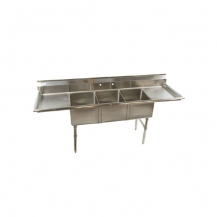3 Compartment Sinks
-
-
-
Special Price $583.99 $606.00
-
-
Special Price $817.99 $849.00
-
-
Special Price $360.99 $375.00
-
Special Price $885.99 $920.00
-
Special Price $951.99 $988.00
Stainless Steel Commercial 3-Compartment Sinks
A commercial 3-compartment sink is the centerpiece of any food preparation workspace. Without one, your kitchen is a minefield for food-borne diseases. The 3-sink method requires washing, rinsing, and sanitizing all kitchen utensils in a separate compartment. Three-compartment sinks can help foodservice establishments stick firmly to FDA and local health regulations when installed and used correctly.
Why Do You Need a 3-Compartment Sink?
FDA food code stipulates that industrial kitchens include at least one commercial 3-compartment sink. A power problem or malfunction may disable your commercial dishwashers. In that case, a stainless steel three-compartment sink can be your lifebuoy. Besides, some kitchenware has irregular dimensions or delicate surfaces. It is not safe to wash such utensils in a dishwasher.
Code-compliant dishwashing process necessitates dipping every piece of equipment fully into hot water in each compartment. Each compartment must be large enough to immerse the largest kitchenware in your establishment. The third section in a three-compartment sink is for sanitizing. Utensils must be entirely submerged in a solution in the third sink for a minimum of 30 seconds, and this period may change from state to state.
How to Shop 3-Compartment Sinks?
Stainless steel 3-compartment sinks are standard models on the market, but the grade of the steel may change. You will see 304 or 430 stainless steel types. Although they are both remarkably durable, type 304 is known to have more resistance against rust.
These sinks come in with or without drainboards, which are again stainless steel. The three-compartment sinks with drainboards on each side occupy more footprints. Drainboards are necessary to air-dry the dishes, so you will have to buy drainboards anyway. Your available space and the size requirement in a three-compartment sink will specify what size you need.
3-compartment sink faucets are mounted on their backsplash guards. You can choose a swing spout or a gooseneck faucet. Finally, you may see variations in gauge. It indicates the thickness of the steel used in the construction. The gauge can vary on top, front apron, and legs. The lower the gauge is, the thicker the steel.
How to Clean Dishes in a 3-Compartment Sink?
Buying a quality 3-compartment kitchen sink is not enough. It is vital to follow specific guidelines when washing tableware in a three-compartment sink. First, the 3-sink method dictates using each compartment solely for the designated purpose. To ensure this, you can label the sinks. Employees should also know which activity is not allowed in a commercial 3-compartment sink. Washing hands, disposal of mop water or other dirty liquids, and thawing frozen food are against the code. Finally, it is essential to set the three-compartment sink temperatures correctly. The first two compartments must be filled with water at a minimum temperature of 110 ◦F. The third compartment temperature must be at least 171 ◦F.
Industrial kitchens are packed with food contact surfaces, which must be sterilized using a solution safe for employees. Common 3-compartment sink sanitizers are quats, chlorine, and iodine. After all this groundwork, you can follow the three-compartment sink steps below:
- Rub off the food leftovers on the dishes.
- Wash them in the first sink with hot soapy water.
- The second compartment is for rinsing.
- Dip the dishes into the third sink for at least 30 seconds.
- Air-dry the dishes on drainboards.
Loss of prestige and customers, lawsuits, and hefty fines are just a few of the frustrating consequences of food-borne illnesses. 3-compartment sinks provide sanitation and relieve you from such concerns.















